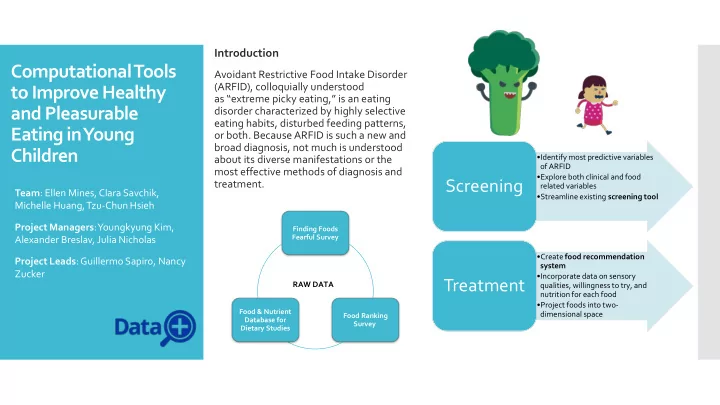

Introduction Computational Tools Avoidant Restrictive Food Intake Disorder (ARFID), colloquially understood to Improve Healthy as “extreme picky eating,” is an eating and Pleasurable disorder characterized by highly selective eating habits, disturbed feeding patterns, Eating in Young or both. Because ARFID is such a new and broad diagnosis, not much is understood Children •Identify most predictive variables about its diverse manifestations or the of ARFID most effective methods of diagnosis and •Explore both clinical and food Screening treatment. related variables Team : Ellen Mines, Clara Savchik, •Streamline existing screening tool Michelle Huang, Tzu-Chun Hsieh Project Managers :Youngkyung Kim, Finding Foods Fearful Survey Alexander Breslav, Julia Nicholas •Create food recommendation Project Leads : Guillermo Sapiro, Nancy system Zucker •Incorporate data on sensory Treatment RAW DATA qualities, willingness to try, and nutrition for each food •Project foods into two- Food & Nutrient dimensional space Food Ranking Database for Survey Dietary Studies
ARFID Screening Clinical and Behavioral Scales, model accuracy = 70% Random Forest Confusion Matrix (Average) • Goal: Identify the best variable predictors of ARFID • Clinical and behavioral subscales (CAST, CEBQ, PFQ, SDQ) • Various food preferences Recall = 0.688, precision = 0.698 , f1 = 0.688 Food Preferences, model accuracy = 64% Confusion Matrix Future Work • Create faster and more streamlined screening process for ARFID doctor consultation • Improve accuracy Macro-Average: Recall = 0.51, precision = 0.54, f1 = 0.47
ARFID Treatment Goal: Recommend new foods to children Food Exploration Tool based on “similar picky children” eat. • Each point on the scatterplot represents a food • Positioned based on picky eaters’ ratings of how sweet, sour, salty, Recommendation system chewy, and crunchy the food is • • Categorizing Methods Highlight points by category • • perception, human behavior, nutrition Options to display nutrition information and/or show food • Clustering recommendations • Dimension reduction: PCA, t-SNE • Clustering methods: K-means, GMM, SOM • Heat Map Link: http://my- • Distance between food based on experience of trying food- exploration.s3- website-us- west- 1.amazonaws.c om/ Future Work • Create a mobile application for more convenient use of the food exploration system Ice cream Pudding Yogurt Eggs
Appendix: Heat Map for meat
Food Preference Variable Index
Recommend
More recommend